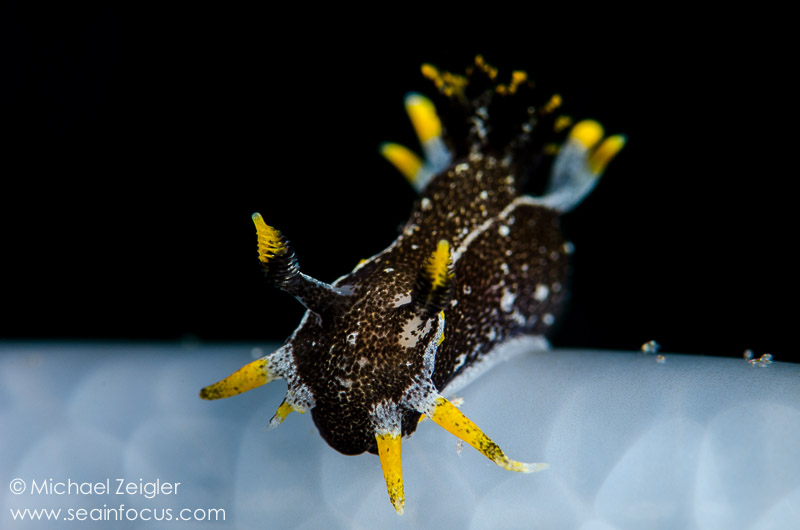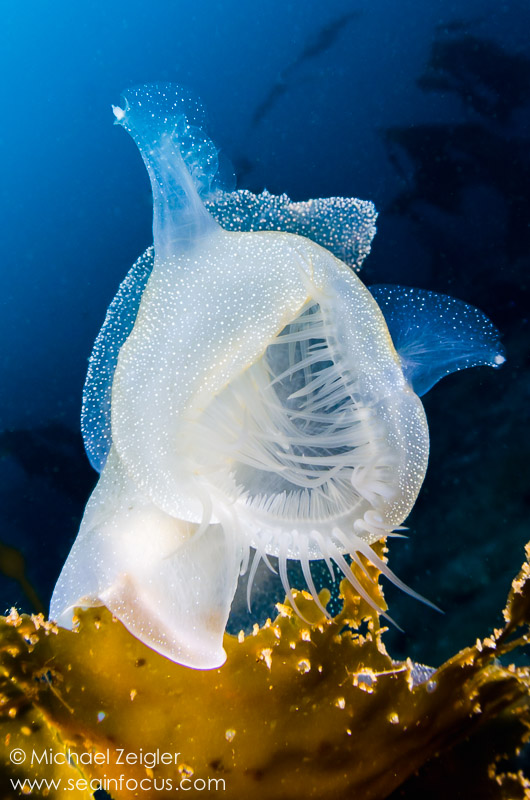When it comes to small colorful marine animals, it’s hard to compete with nudibranchs. Often referred to as sea slugs, nudibranchs have been described as some of the most beautiful creatures in our oceans. With thousands of different species throughout the world, there seems to be an endless supply of diverse shapes, sizes, and color patterns to photograph. We have over 130 different species along the California coast alone. With sizes ranging from 1/8 inch to over 12 inches, you can use a variety of different lenses to capture your desired image. Macro lenses like the Nikon 60mm, Canon 60mm, Nikon 105mm VR, or Canon 100mm IS are some of the more popular nudibranchs lenses. Butfisheye lenses, like the Tokina 10-17mm and Canon 8-15mm, can also be used to create some stunning images, especially with some of the larger nudibranchs. To keep your nudibranch photographs interesting, composition and negative space become just as important as the subject. Simply shooting down won’t cut it, you need to get at eye level with them. Many nudibranchs do have eyes, but they are just incredibly small. Separating the nudibranch from the background by shooting with a wide aperture or getting low and having open water behind the subject are good techniques to keep your nudibranch from blending in with the surrounding reef. Please enjoy a few of our favorite California nudibranch images.
 Polycera hedgpethi nudibranch on a market squid egg casing - Catalina Island, California. Nikon D7000 in a Sea & Sea housing, 105mm macro lens, Ikelite DS160 strobes. 1/250, ƒ/18, ISO 125.
Polycera hedgpethi nudibranch on a market squid egg casing - Catalina Island, California. Nikon D7000 in a Sea & Sea housing, 105mm macro lens, Ikelite DS160 strobes. 1/250, ƒ/18, ISO 125.
 Dirona picta, Redondo Beach. Canon 5D Mark III, EF 100mm f/2.8 Macro IS, dual Ikelite strobes - 1/200, f/14, ISO 100
Dirona picta, Redondo Beach. Canon 5D Mark III, EF 100mm f/2.8 Macro IS, dual Ikelite strobes - 1/200, f/14, ISO 100
 Tiny Catriona columbiana nudibranch at Veterans Park in Redondo Beach, California. Nikon D7100 in a Sea & Sea housing, 105mm macro lens plus SubSee +5, Ikelite DS160 strobes. 1/250, ƒ/36, ISO 400. During this night dive I used a Light & Motion SOLA 800focus light.
Tiny Catriona columbiana nudibranch at Veterans Park in Redondo Beach, California. Nikon D7100 in a Sea & Sea housing, 105mm macro lens plus SubSee +5, Ikelite DS160 strobes. 1/250, ƒ/36, ISO 400. During this night dive I used a Light & Motion SOLA 800focus light.
 Hermissenda, Redondo Beach. Canon 5D Mark III, EF 100mm f/2.8 Macro IS, 1/160, f/13, ISO 100
Hermissenda, Redondo Beach. Canon 5D Mark III, EF 100mm f/2.8 Macro IS, 1/160, f/13, ISO 100
 Melibe leonina nudibranch at Catalina Island, California. Nikon D7000 in a Sea & Sea housing, Tokina 10-17mm fisheye lens @ 17mm behind a Zen 100mm dome, Ikelite DS160 strobes. 1/50, ƒ/16, ISO 400.
Melibe leonina nudibranch at Catalina Island, California. Nikon D7000 in a Sea & Sea housing, Tokina 10-17mm fisheye lens @ 17mm behind a Zen 100mm dome, Ikelite DS160 strobes. 1/50, ƒ/16, ISO 400.
 Janolus on kelp, Catalina island. Canon 5D Mark III, EF 100mm f/2.8 Macro IS, Nauticam SMC, 1/100, f/14, ISO 100
Janolus on kelp, Catalina island. Canon 5D Mark III, EF 100mm f/2.8 Macro IS, Nauticam SMC, 1/100, f/14, ISO 100
 Dirona picta at La Jolla Shores in San Diego, California. Nikon D7000 in a Sea & Sea housing, 60mm f/2.8 AF-D macro lens, Ikelite DS160 strobes. 1/160, ƒ/16, ISO 100.
Dirona picta at La Jolla Shores in San Diego, California. Nikon D7000 in a Sea & Sea housing, 60mm f/2.8 AF-D macro lens, Ikelite DS160 strobes. 1/160, ƒ/16, ISO 100.
 Hopkin's Rose, Catalina island. Nikon D2X, 60mm f/2.8 Macro, 1/200, f/16, ISO 100
Hopkin's Rose, Catalina island. Nikon D2X, 60mm f/2.8 Macro, 1/200, f/16, ISO 100
 Todd Winner is a contributor, instructor, and trip leader for Samy’s Underwater Photo & Video. He has over 20 years of experience in underwater still and broadcast video.
To see more of Todd’s work please go to www.toddwinner.com.
Todd Winner is a contributor, instructor, and trip leader for Samy’s Underwater Photo & Video. He has over 20 years of experience in underwater still and broadcast video.
To see more of Todd’s work please go to www.toddwinner.com.
 Michael Zeigler is a contributor, instructor, and trip leader for Samy’s Underwater Photo & Video as well as an AAUS Scientific Diver.
To see more of Micheal’s work please go towww.seainfocus.com
Michael Zeigler is a contributor, instructor, and trip leader for Samy’s Underwater Photo & Video as well as an AAUS Scientific Diver.
To see more of Micheal’s work please go towww.seainfocus.com
 Polycera hedgpethi nudibranch on a market squid egg casing - Catalina Island, California. Nikon D7000 in a Sea & Sea housing, 105mm macro lens, Ikelite DS160 strobes. 1/250, ƒ/18, ISO 125.
Polycera hedgpethi nudibranch on a market squid egg casing - Catalina Island, California. Nikon D7000 in a Sea & Sea housing, 105mm macro lens, Ikelite DS160 strobes. 1/250, ƒ/18, ISO 125.
 Dirona picta, Redondo Beach. Canon 5D Mark III, EF 100mm f/2.8 Macro IS, dual Ikelite strobes - 1/200, f/14, ISO 100
Dirona picta, Redondo Beach. Canon 5D Mark III, EF 100mm f/2.8 Macro IS, dual Ikelite strobes - 1/200, f/14, ISO 100
 Tiny Catriona columbiana nudibranch at Veterans Park in Redondo Beach, California. Nikon D7100 in a Sea & Sea housing, 105mm macro lens plus SubSee +5, Ikelite DS160 strobes. 1/250, ƒ/36, ISO 400. During this night dive I used a Light & Motion SOLA 800focus light.
Tiny Catriona columbiana nudibranch at Veterans Park in Redondo Beach, California. Nikon D7100 in a Sea & Sea housing, 105mm macro lens plus SubSee +5, Ikelite DS160 strobes. 1/250, ƒ/36, ISO 400. During this night dive I used a Light & Motion SOLA 800focus light.
 Hermissenda, Redondo Beach. Canon 5D Mark III, EF 100mm f/2.8 Macro IS, 1/160, f/13, ISO 100
Hermissenda, Redondo Beach. Canon 5D Mark III, EF 100mm f/2.8 Macro IS, 1/160, f/13, ISO 100
 Melibe leonina nudibranch at Catalina Island, California. Nikon D7000 in a Sea & Sea housing, Tokina 10-17mm fisheye lens @ 17mm behind a Zen 100mm dome, Ikelite DS160 strobes. 1/50, ƒ/16, ISO 400.
Melibe leonina nudibranch at Catalina Island, California. Nikon D7000 in a Sea & Sea housing, Tokina 10-17mm fisheye lens @ 17mm behind a Zen 100mm dome, Ikelite DS160 strobes. 1/50, ƒ/16, ISO 400.
 Janolus on kelp, Catalina island. Canon 5D Mark III, EF 100mm f/2.8 Macro IS, Nauticam SMC, 1/100, f/14, ISO 100
Janolus on kelp, Catalina island. Canon 5D Mark III, EF 100mm f/2.8 Macro IS, Nauticam SMC, 1/100, f/14, ISO 100
 Dirona picta at La Jolla Shores in San Diego, California. Nikon D7000 in a Sea & Sea housing, 60mm f/2.8 AF-D macro lens, Ikelite DS160 strobes. 1/160, ƒ/16, ISO 100.
Dirona picta at La Jolla Shores in San Diego, California. Nikon D7000 in a Sea & Sea housing, 60mm f/2.8 AF-D macro lens, Ikelite DS160 strobes. 1/160, ƒ/16, ISO 100.
 Hopkin's Rose, Catalina island. Nikon D2X, 60mm f/2.8 Macro, 1/200, f/16, ISO 100
Hopkin's Rose, Catalina island. Nikon D2X, 60mm f/2.8 Macro, 1/200, f/16, ISO 100
 Todd Winner is a contributor, instructor, and trip leader for Samy’s Underwater Photo & Video. He has over 20 years of experience in underwater still and broadcast video.
To see more of Todd’s work please go to www.toddwinner.com.
Todd Winner is a contributor, instructor, and trip leader for Samy’s Underwater Photo & Video. He has over 20 years of experience in underwater still and broadcast video.
To see more of Todd’s work please go to www.toddwinner.com.
 Michael Zeigler is a contributor, instructor, and trip leader for Samy’s Underwater Photo & Video as well as an AAUS Scientific Diver.
To see more of Micheal’s work please go towww.seainfocus.com
Michael Zeigler is a contributor, instructor, and trip leader for Samy’s Underwater Photo & Video as well as an AAUS Scientific Diver.
To see more of Micheal’s work please go towww.seainfocus.com





